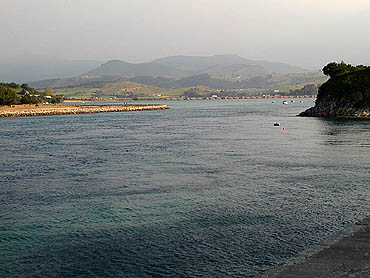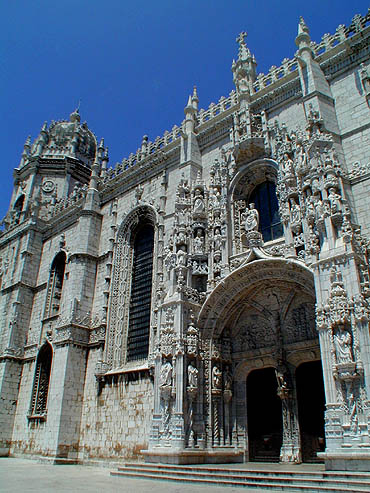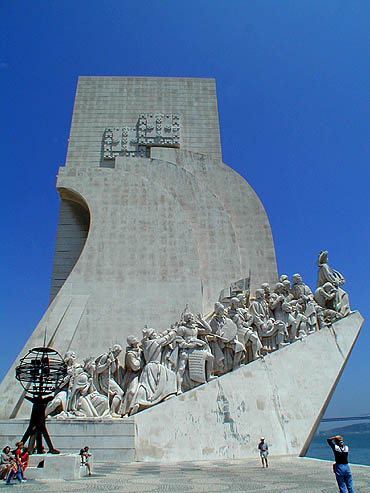
Modern, cramped
and ugly describe our first impressions of Northern Spain. Even the coastal
towns, lying on picturesque stretches of the Atlantic Ocean, lacked any
hint of charm or beauty. A stark scene of billowing smoke stacks and huge
factories greeted us as we drove through the outskirts of Bilbao. As we
rounded the curve into the city center, an unexpected sight suddenly appeared,
resembling a large ship navigating the river: The Bilbao Guggenheim Museum
(pictured above).  In an attempt to precipitate a new course for development, overcome its industrial legacy, and become an internationally recognized location, Bilbao's government and town planners elected to spend a majority of the one hundred million dollars to build this architectural masterpiece.
In an attempt to precipitate a new course for development, overcome its industrial legacy, and become an internationally recognized location, Bilbao's government and town planners elected to spend a majority of the one hundred million dollars to build this architectural masterpiece.
American architect Frank O. Gehry instilled his fascinations for curvature and fish into this spectacular structure. He also incorporated the latest material and building technologies to attain his grand, flowing design, and meet budget and time requirements. It took over a year only to discover the perfect titanium alloy formulation used for the fish-scale-like panels connected to form the exterior covering. State-of-the-art CAD/CAM computer systems instructed robots to cut and polish the thin limestone panels assembled on aluminum sub frames to create interior and exterior columns and walls. Since the entire building incorporates only curved surfaces, each panel has slightly different dimensions. Specialized glass plates erected in a similar fashion form the tall, curving, light infusing surfaces of the central atrium. We had not planned to remain in Bilbao, but the museum demanded a one day stay.
The genius structure eclipsed the contemporary art collection inside. The audio guide described in detail the processes of selecting an architect, design and building, including insightful quotes from Frank O. Gehry. The combination of titanium, glass and stone achieves both a classical and modern feel. All galleries are connected to the atrium, providing the visitor with relaxing views, air and light between exhibits. We have yet to discover a more impressive and comfortable facility for viewing art. At the entrance to the museum stands another brilliant art piece. "The Puppy" (photo left), commissioned from Jeff Koons, stands 40 feet tall. The American artist used 60,000 live flowers of varying types and colors to create the sculpture's coat, all in bloom on the day of our visit.
In San Vincente de la Barquera we finally found the tranquil seaside village we had envisioned (photos below). So far, the scourge of high-rise hotel hell has not arrived at this lovely place. Gentle hills disturbed only by the farmer's plow rolled down onto the long, cresent-shaped, white beach. At low tide, the width of the sandy beach doubled, and children played in small tide pools left around rock formations that grace the shore landscape. A narrow inlet leads to a large shallow bay formed by the emptying of a tributary, and the ebbs and flows of the ocean. Local fishermen and yacht owners anchor their boats there, and smaller vessels secured closer to shore are left laying on the sand when the waters make their daily departures.
Our decorous, low-rise hotel sat on a hill overlooking the town, bay and sea. We enjoyed these views from the balcony of our cozy, reasonably priced room. We ate one of the finest meals of our trip at a small, unassuming restaurant situated at the bottom of the hill next to the channel (red house in the left photo). We sat on the sunny terrace of the empty establishment while a pleasant Spanish gentlemen served us delicious salads, buttery filet steak, inch-thick asparagus topped with thin slices of grilled smoked salmon, and brilliant desserts. A bottle of Spanish wine and local digestif provided the perfect liquid accompaniments. I salivate whenever I recall this wonderful, unexpected feast. I spent the first afternoon jumping in the frolicking waves; the next day we took a long walk along the smooth beach. We so enjoyed the natural, peaceful terrain!


Negotiating the tiny roads through a steep river gorge in the Picos de Europa mountain range, we encountered a hidden Roman bridge (photo below right). We stayed in charming Arenas de Cabrales to hike a famous trail between the area's majestic peaks (photo left). Beautiful weather during our seven-hour hike gave us the opportunity to appreciate the full splendor of this rugged, steep and wild terrain. The trip included foot brides and paths with 600-foot drops only a slip away, aggressive ascents and descents, and cave-like walk-throughs. The roar of the river below provided the ideal musical backdrop.


 At Santiago de Compostela a huge cathedral stands over the alleged remains of the apostle St. James (photo right). For 800 years, religious people have walked the legendary Camino de Santiago, a 900 kilometer pilgrimage to this site, believing to half their time in purgatory. We hope to receive some credit for our three-hour drive to this spiritually significant location. One day granted enough time to tour the old town and famous church. Four facades executed in separate time periods and different architectural styles give this church structure a unique character. The tiny streets with porticoed medieval buildings showcased Spanish building design.
At Santiago de Compostela a huge cathedral stands over the alleged remains of the apostle St. James (photo right). For 800 years, religious people have walked the legendary Camino de Santiago, a 900 kilometer pilgrimage to this site, believing to half their time in purgatory. We hope to receive some credit for our three-hour drive to this spiritually significant location. One day granted enough time to tour the old town and famous church. Four facades executed in separate time periods and different architectural styles give this church structure a unique character. The tiny streets with porticoed medieval buildings showcased Spanish building design.
The European Union certainly makes country hopping a breeze. A short ride by car ferry, and we had entered Portugal. Driving down the coast towards Porto, we searched for the famed Portuguese fishing villages ... and never found them. We camped along the ocean at a beautiful site under a canopy of umbrella pine trees. The nearby seaside village and shoreline offered an unappealing array of trash and unkempt buildings and properties. The city of Porto disappointed as much, except for the variety of port wine lodges, where we discovered the procedures of making and the pleasures of drinking this intoxicating beverage. We had not expected the amount of industry surrounding the city or its overall state of disrepair. These conditions prevailed throughout most of the country.
Of course, gems lie buried under the dirt, and we managed to find our share. The port lodge tours introduced us to the Duoro Valley, home to the vineyards that produce the illustrious grapes for this magical elixir. Our guide at Sandeman recommended a visit to the area, and gave us directions for an easy highway route. The camp ground manager suggested we take the scenic drive along the coastline to Porto and follow the Duoro River inland to our destination. Selecting the latter plan rewarded us with a seven-hour trip from hell replete with windy roads up and down the mountains, invisible signs, several incorrect deviations, and my uncontrollable swearing. However, this deplorable experience set the stage for our arrival in paradise.
Our adventure left me so exhausted that I insisted on securing a room at any price. The report of their fully booked status at the first-class Vintage Hotel left me close to weeping. The gentlemen at the reception offered an alternative and sent us to a B&B property in close proximity. We reached the village of Chanceleiros after a twenty minute climb up windy roads through vineyard terraces. Behind the luxurious main villa of the hotel estate, six gorgeous slate stone buildings with nine guest rooms, a bar and roofed sitting areas encircle an inviting blue pool. Situated on a sloping hillside, the structures fall away from the main house like a cascading waterfall. Beautiful landscaping with olive trees, flowers and plants adds to this harmonious Garden of Eden. Below the pool area stands a tennis court, racquet ball facility and whirlpool spa. Low mountains covered with terraced vines surround the estate, providing breathtaking views (photos below). A one-night stay quickly turned into two.
On the first evening, our hostess Adelaide and her staff prepared a delightful meal for all the guests. We sat at the table on the verandah of the villa with two gentlemen from the BBC, on location filming a documentary, and a vintner couple from Napa Valley. Shortly after sunset a gigantic, orange full moon rose over the mountains. We ate, drank and talked until 2:00 am, consuming a sizable quantity of port wine. The night exudes legendary traits. The next day we swam in the pool, absorbed the vistas and smiled ceaselessly. The atmosphere, service and treatment made us feel completely at ease. The second night we exchanged stories, laughed and appreciated another full moon rise while dining with Adelaide. At the end of two days we felt like family members. We hope to assemble a group of friends and book all the rooms for a fall grape stomping and port tasting escapade. Stay tuned!


For our excursions to Lisbon we decided to stay outside the city in a smaller village called Sintra and commute by train. Portuguese nobility built numerous castles and palaces in and around this small town. We spent the first day touring two of the more famous royal residences. An unending spectacle of ugly high-rise apartment buildings greeted us on our train journey into Lisbon. It saddened us to consider that a majority of the population lives in these depressing conditions. On the other hand, we learned that Portugal constructed more roads in the last ten years than any other European country. Modernization comes at a cost.
Two days provided more than enough time to see the country's largest metropolis. The outlying neighborhood of Belem contains most of the monuments and museums. In one afternoon we visited the Mosteiro dos Jeronimos, a beautiful monastery established to celebrate the age of discovery, Torre de Belem, an ancient harbor fortress, and Padrao dos Descobrimentos, a giant memorial built to honor Prince Henry the Navigator. The rest of the time we walked through the popular quarters trying to capture a glimpse of life in Lisbon. Most of the areas need work. Many buildings lie in decay. A condition of excess dirt and garbage prevailed on the side streets. Perhaps economic growth and financial investment under the EU will provide the capital for necessary reconstruction and beautification projects. The possibility for this city to achieve international acclaim remains within reach.


Above left: Torre de Belem, right: in Lisbon's center. Below left: Mosteiro dos Jeronimos, right: Padrao dos Descobrimentos


The most glorious palace in Portugal, which includes a basilica patterned after St. Peter's in Rome, stands at Mafra (below left). The dome of the church almost reaches the size of St. Peter's cupola. Amazing large marble sculptures stand in niches of the exterior facade and loggia, and along the main nave and in the many side chapels inside. The finest colored marbles from all over Europe adorn the interior walls and columns. Six organs, currently under restoration, will play again in 2006 compositions written for them specifically. The royal residence built on the magnitude of Versailles remains perfectly intact and includes an incredible library containing 38,000 volumes dating back to the 17th century.
In Sagres, the southwestern most corner of Europe, Prince Henry the Navigator established his famous school of navigation, leading to Portugal's leading position during the age of discoverers. Shear cliffs reach strait up from the sea to this barren, virtually treeless desert plateau (below right). We experienced some of Portugal's most beautiful beaches and amazing ocean vistas while camping in this isolated location. The dry, burnt landscapes and overheated conditions deterred us from staying in southern Spain. We made a swift exit feeling more inclined to take our chances in Rome. We will save the rest of Spain for another visit during the spring or fall seasons.


Perhaps we had arrived in both countries with the wrong expectations. We had anticipated sleepy, whitewashed villages and clean, romantic towns displaying few signs of mainstream tourism, not industrialization, pollution and dense population. We had mistakenly embraced idyllic descriptions, leaving little room for reality. But among the gray, crowded landscapes of modern life, we discovered bright oases, artistic grandeur and rare beauty. Persistence prevailed and luck provided, granting us some of the best surprises of our trip. So let it roll, because the good stuff lurks just around the corner!